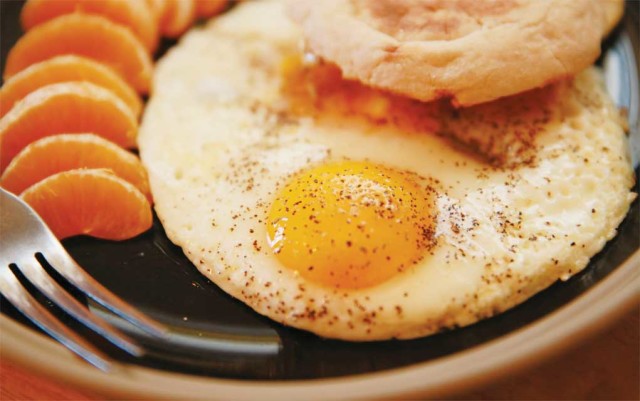
Me and fad diets go way back. Mom told me that when I was a toddler doctors advised her to feed me an egg a day to make me strong. I saw a lot of cottage cheese and grapefruit in the ’60s, followed by variations on the high protein, high fiber and nonfat diets.
I may be a bit jaded. Foods have come in and out of favor like bell bottom jeans and beards. Butter was once banished and margarine was in; now butter and even lard are back. Kale was always a garnish, and now it’s an entrée.
It’s not often that I cheer when a government agency issues guidelines, but there are a few things to love in the recently updated 2015-2020 Dietary Guidelines issued by the United States Department of Agriculture. As an unabashed breakfast fan and lover of all things hollandaise, quiche and custard, I’m happy to hear that whole eggs are cool again.
For decades my over-easy eggs have been served with a supersized side order of guilt. Egg yolks with their cholesterol and fat were banished. Good people, myself included, actually started eating yolkless egg substitute in pursuit of better health. Now the USDA says there is “no appreciable relationship between consumption of dietary cholesterol and serum [blood] cholesterol.” There is still a daily cholesterol limit but that gets you about two large eggs a day, assuming you didn’t scarf down any other cholesterol.
You are encouraged to eat fat, good fat that is, and more lean protein from seafood, lean meat and chicken. Bacon is not absolutely banned, but the new guidelines don’t exactly recommend it either. You are allowed only about 20 grams of saturated fat a day or about 4 ounces of certain incredibly delicious cheeses. That’s barely a grilled cheese sandwich.
I’m already way better than the guidelines including eating at least 8 ounces of seafood per week, along with at least 2.5 cups of various vegetables of all types and colors and 2 cups of whole fruit a day. I do eat a diet that includes a lot of whole grains, beans, nuts and seeds.
I do OK with salt and sugar except during football games. The guidelines recommend about a teaspoon of salt a day, and for the first time the guidelines put daily limits on added (non-fruit) sugar of about 50 grams of sugar. That only gets you one can of full sugar soda a day … and no cake.

Alcohol is OK in moderation. Women should have no more than one drink a day and guys get two. Can men save them up and have 14 on a Saturday night? No, we can’t. Unlike cell phone minutes, unused alcohol does not roll over into the following week. Wine is still the preferred beverage for its heart health benefits.
For the first time in guideline history, caffeine is given a little hug. Up to five cups a day of coffee is considered “moderate” consumption. The down side? Those are actual measured cups, not mugs, and only about 400 total milligrams of caffeine. There goes that triple espresso at 2 p.m.
The real big bottom line in all of this is total calories. These average recommended diets are based on a hypothetical 2,000 total calories a day, more or less depending on overall weight, BMI, fitness quotient, blah, blah, blah — you know, the usual diet stuff.
These guidelines (updated every five years since 1980) are pitched as being more user-friendly by detailing a 2,000-calorie diet in three tasty varieties: the healthy American diet, the healthy Mediterranean diet and the healthy vegetarian diet. It means that when you lose control with that bag of cookies and a pint of Nutella gelato it’s easy to blow three diets simultaneously.
Caution is advised. This is just the latest in a long series of food fights between dieticians, scientists and various special interest groups. And given my track record I wouldn’t take any dietary advice from me. Consult an oracle and read the guidelines yourself at: health.gov/dietaryguidelines/2015/guidelines.
If you don’t like them, the guidelines will change in five years.
Taste of the Week
Skip the sweet and sour chicken and moo shu and get real at Boulder’s Jin Chan Zhang, 2835 28th St. The low-key Chinese eatery’s traditional menu section boasts such classics as crispy duck, frog leg hot pot and the warming shredded beef with jalapenos. Don’t miss the chalkboard specials like the chewy fried peanut or scallion pancakes ($2 each) as a starter. Dip the pancake in sriracha and black bean (hoisin) sauces. Repeat as needed.

Eat and drink the best locals
The Good Food Awards are the Oscars of the burgeoning American artisan food world with 1,927 entrants in 13 categories in 2016 from beer to preserves, spirits and pantry. Among the top award winners are Boulder’s JJ’s Sweets for their Coconut Palm Sugar Cocomel candy. Basalt’s Avalanche Cheese Company won with the makings of a great sandwich in two categories: Hand Bandaged Goat Cheddar and Pork and Goat Finocchiona Salami.
Other Colorado Good Food Award-winners include James Ranch Artisan Cheese (Durango), Big B’s Hard Cider (Hotchkiss), Commonwealth Coffee (Denver), Bee Squared Apiaries (Berthoud), Decadence Gourmet (Grand Junction), Modern Gingham Preserves (Denver) and Marble Distilling Co. Moonlight Expresso (Carbondale).
Meanwhile at Britain’s prestigious Global Cheese Awards, Blue Moose of Boulder earned top awards for its MontAmore & Roasted Green Chile cheese spread and Truffled Ricotta dip. You’ll find them next to the hummus at your local grocer.
Words to chew on
“Don’t most of us these days find ourselves nibbling standing up, or while we’re on the phone, or as we’re watching the TV? The question is, with all these distractions, do we ever truly taste whatever it is we’re eating — and exactly how do we know when we’re full?” – from The Zen of Food (Berkley) by Sallyann Murphey.
John Lehndorff hosts Radio Nibbles at 8:25 a.m. Thursdays on KGNU, 88.5 FM, 1390 FM, kgnu.org. Listen to archived shows at news.kgnu.org/category/radio-nibbles. Send your comments, quibbles and Boulder County restaurant and bakery news to: [email protected].














